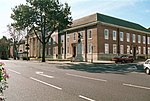St Mary of the Angels, Worthing
19th-century Roman Catholic church buildings in the United KingdomChurches in WorthingFrederick Walters buildingsGothic Revival architecture in West SussexGothic Revival church buildings in England ... and 5 more
Grade II listed churches in West SussexHenry Clutton buildingsRoman Catholic churches completed in 1864Roman Catholic churches in West SussexUse British English from May 2015

The Church of St Mary of the Angels, Worthing, is in Worthing, West Sussex, England. It is a Grade II listed building and the earliest of the four Roman Catholic churches in Worthing. It is an active Roman Catholic parish church in the diocese of Arundel & Brighton and the Worthing deanery.
Excerpt from the Wikipedia article St Mary of the Angels, Worthing (License: CC BY-SA 3.0, Authors, Images).St Mary of the Angels, Worthing
Crescent Road,
Geographical coordinates (GPS) Address External links Nearby Places Show on map
Geographical coordinates (GPS)
| Latitude | Longitude |
|---|---|
| N 50.8132 ° | E -0.3773 ° |
Address
St Mary of the Angels
Crescent Road
BN11 4AA , West Worthing
England, United Kingdom
Open on Google Maps









